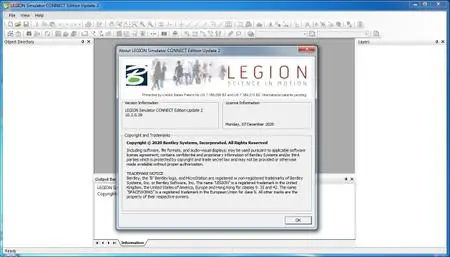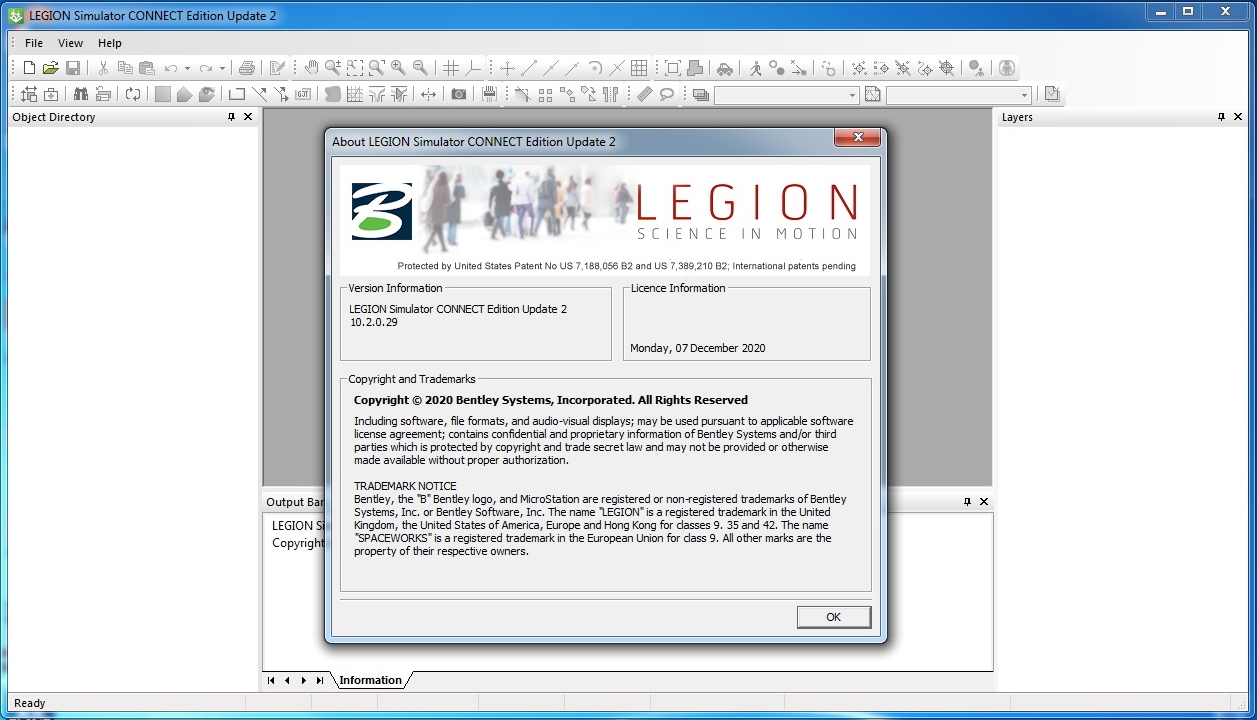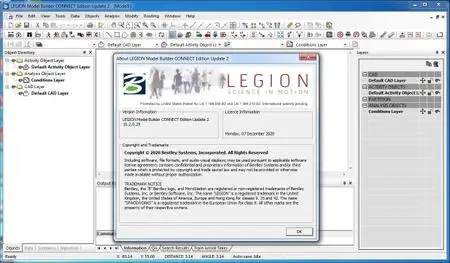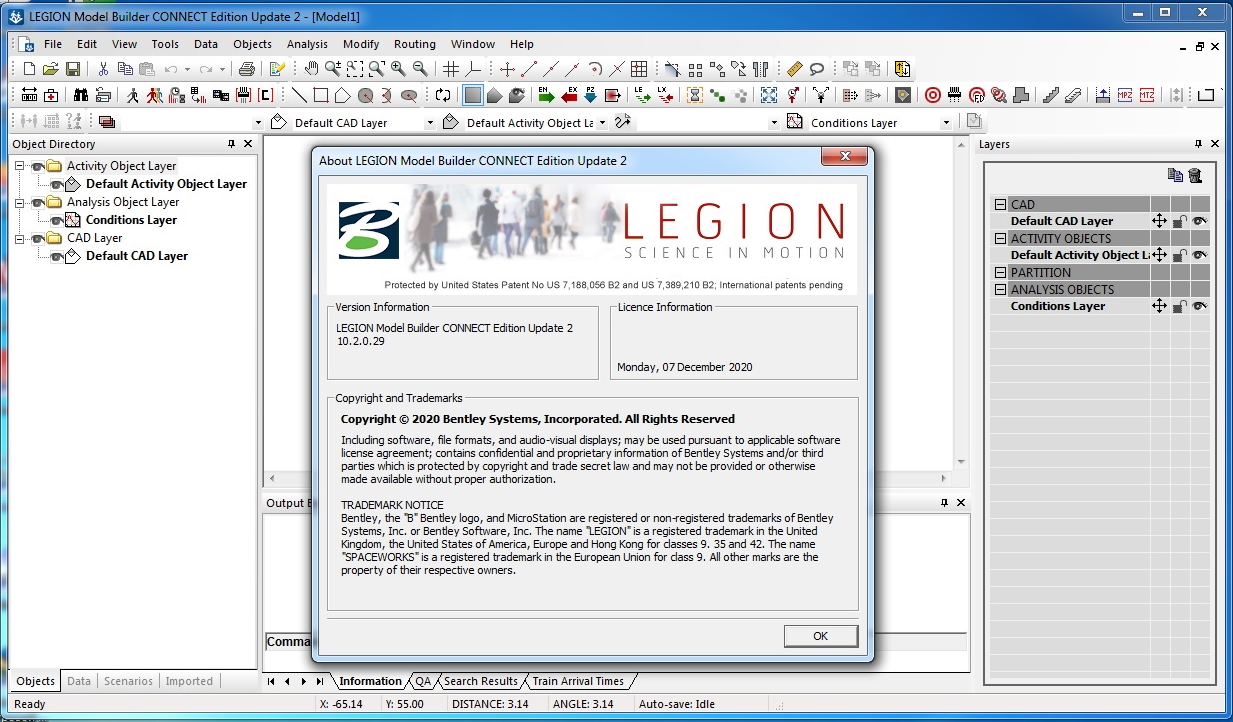LEGION ModelBuilder / Simulator CONNECT Edition Update 2 | 576.1 mb
The OpenBuildings development team is pleased to announce the availability of LEGION ModelBuilder / Simulator CONNECT Edition Update 2 (build 10.2.0.29). This software helps enhance pedestrian flow and improve safety by allowing the users to test evacuation strategies at any point of the simulations.
Platform - Train Interface (PTI)
The Train Interface (PTI) is moved from [Technology Preview] to commercial release.
- Various improvements and bug fixes based on user feedback from the [Technology Preview].
- "Yellow Line" Enhancement - You can now specify the "yellow line" when drawing a Platform. Involves an extra step in the drawing command, after the option to simplify platform edge vertices. The Platform property dialog has a field for setting the distance from platform edge to yellow line.
- Edit Carriage Data - For train carriages, you can now edit Door Markings and Join Points.
- Improvements to Naming of Train Carriages - Previously, the Train Carriage name could not be set without accessing the Save to Catalog dialog, after setting the Carriage properties. In this edition of LEGION Model Builder, the Carriage parameters dialog has new data fields "Name" and "Notes (optional)".
- Train Visualization Improvements - In LEGION Simulator, accessible spaces for Trains are displayed next to their Platform when a Train has arrived, and are hidden when Trains depart.
- Platform Edge / CAD association - Platform edge is now permanently associated with one or more CAD elements.
- Note: Platforms defined in Update 1 must be redefined in Update 2, to create the permanent Platform edge/CAD element association.
- Populate alighters near the doors - A new option in Train Services. Alighting entities are usually distributed randomly throughout a Service's Carriage interiors. Checking this option populates alighting entities next to the Train doors in a Service's Carriages, producing a less impeded alighting behavior.
Capacity by Density
Delay Points and Waiting Zones can now accept a desired pedestrian density in place of capacity. For example, Fruin Level of Service C. Object capacity is then automatically calculated from that density and the object's accessible area.
Social Distancing Enhancements
A variety of modelling and analysis tools have been added, to help modelling environments where social distancing is required.
- Capacity Calculator - Social distancing vastly reduces the capacity of waiting areas. Delay Point and Waiting Zone have a Capacity Calculator to help understand capacity based on social distancing.
- Socially-distanced Waiting Area - Quickly and easily define waiting areas which enforce social distancing between pedestrians.
- Socially-distanced Queue - Quickly and easily define complex queuing structures which enforce social distancing between pedestrians.
- Occupancy Estimator - Understand what social distancing means for maximum occupancy of a venue and its various pedestrian spaces. Use this tool to calculate upper limits of socially-distanced occupancy, and compare with normal Occupancy Ratings.
- Social Distancing Proximity Breach Maps - Show areas of a model where social distancing is not being adhered to, and for how long. Helps identify areas where managed intervention may be needed to enforce social distancing.
- Entity Proximity Indicator - Highlights entities whose socially-distanced personal space is encroached by neighboring entities. Helps identify areas where managed intervention may be needed to enforce social distancing.
Journey Time and Generalised Journey Time (JT and GJT) Reporting
Detailed JT and GJT reports now include some information about entities remaining a model at the end of simulation. Previously, only entities leaving the model were added to JT and GJT reports.
- JT reports extra information is: Entity ID, Entity Origin, Model Entry Time, Visit Count for all visited Analyses, First Visit Time, for all visited Analyses
- GJT reports extra information is: Entity ID, Entity Origin, Model Entry Time, Visit Count for all visited GJT Zones, First Visit Time, for all visited GJT Zones
Other entity details about entities remaining a model at the end of simulation are left intentionally blank. Their journeys have not completed so final types and destinations are unknown, and reporting incomplete journey times would actinically reduce average journey times, while increasing Generalized Journey Time social costs.
The Train Interface (PTI) is moved from [Technology Preview] to commercial release.
- Various improvements and bug fixes based on user feedback from the [Technology Preview].
- "Yellow Line" Enhancement - You can now specify the "yellow line" when drawing a Platform. Involves an extra step in the drawing command, after the option to simplify platform edge vertices. The Platform property dialog has a field for setting the distance from platform edge to yellow line.
- Edit Carriage Data - For train carriages, you can now edit Door Markings and Join Points.
- Improvements to Naming of Train Carriages - Previously, the Train Carriage name could not be set without accessing the Save to Catalog dialog, after setting the Carriage properties. In this edition of LEGION Model Builder, the Carriage parameters dialog has new data fields "Name" and "Notes (optional)".
- Train Visualization Improvements - In LEGION Simulator, accessible spaces for Trains are displayed next to their Platform when a Train has arrived, and are hidden when Trains depart.
- Platform Edge / CAD association - Platform edge is now permanently associated with one or more CAD elements.
- Note: Platforms defined in Update 1 must be redefined in Update 2, to create the permanent Platform edge/CAD element association.
- Populate alighters near the doors - A new option in Train Services. Alighting entities are usually distributed randomly throughout a Service's Carriage interiors. Checking this option populates alighting entities next to the Train doors in a Service's Carriages, producing a less impeded alighting behavior.
Capacity by Density
Delay Points and Waiting Zones can now accept a desired pedestrian density in place of capacity. For example, Fruin Level of Service C. Object capacity is then automatically calculated from that density and the object's accessible area.
Social Distancing Enhancements
A variety of modelling and analysis tools have been added, to help modelling environments where social distancing is required.
- Capacity Calculator - Social distancing vastly reduces the capacity of waiting areas. Delay Point and Waiting Zone have a Capacity Calculator to help understand capacity based on social distancing.
- Socially-distanced Waiting Area - Quickly and easily define waiting areas which enforce social distancing between pedestrians.
- Socially-distanced Queue - Quickly and easily define complex queuing structures which enforce social distancing between pedestrians.
- Occupancy Estimator - Understand what social distancing means for maximum occupancy of a venue and its various pedestrian spaces. Use this tool to calculate upper limits of socially-distanced occupancy, and compare with normal Occupancy Ratings.
- Social Distancing Proximity Breach Maps - Show areas of a model where social distancing is not being adhered to, and for how long. Helps identify areas where managed intervention may be needed to enforce social distancing.
- Entity Proximity Indicator - Highlights entities whose socially-distanced personal space is encroached by neighboring entities. Helps identify areas where managed intervention may be needed to enforce social distancing.
Journey Time and Generalised Journey Time (JT and GJT) Reporting
Detailed JT and GJT reports now include some information about entities remaining a model at the end of simulation. Previously, only entities leaving the model were added to JT and GJT reports.
- JT reports extra information is: Entity ID, Entity Origin, Model Entry Time, Visit Count for all visited Analyses, First Visit Time, for all visited Analyses
- GJT reports extra information is: Entity ID, Entity Origin, Model Entry Time, Visit Count for all visited GJT Zones, First Visit Time, for all visited GJT Zones
Other entity details about entities remaining a model at the end of simulation are left intentionally blank. Their journeys have not completed so final types and destinations are unknown, and reporting incomplete journey times would actinically reduce average journey times, while increasing Generalized Journey Time social costs.
LEGION’s pedestrian simulation application offers modeling capabilities of people’s interactions with each other and physical obstacles, and activities, including circulation and evacuations, within public spaces like railway stations, airports, sports arenas, tall buildings, and street level with vehicle interactions. Using LEGION simulation tools in collaborative digital workflows with Bentley’s OpenBuildings Designer (formerly AECOsim Building Designer), architects, engineers and owners can consider pedestrian traffic in their conceptioneering of design alternatives. The newly announced OpenBuildings Station Designer will enable collaborative digital workflows to fully model pedestrian activities and journeys to and from trains, platforms, and through stations.
LEGION Simulator is an analytical application that reads the pedestrian scenario plan of rail and metro stations, stadiums, and other large-gathering venues. The applications help engineers and designers to easily calculate the movement of people within a space. LEGION Simulator includes the data analysis capabilities to review the result with reports, video, and heat maps
LEGION Model Builder is an application used by building designers to import CAD floor plans. The software places pedestrian control and simulation objects within the floor plan to define a scenario of how people would interact within space. The models are the input to LEGION Simulator that performs the analysis resulting in a simulation.
Bentley intends to include the capabilities of LEGION Model Builder in OpenBuildings Station Designer so that pedestrian scenario planning and simulation become an integral part of the BIM design process and facility operations. These capabilities will be added incrementally, over a series of product releases, until all capabilities have been integrated. After successful development of pedestrian scenario planning in OpenBuildings Station Designer, support of LEGION Model Builder will be discontinued.
Bentley has acquired LEGION, the leading developer of a pedestrian simulation software and an essential tool for designing public spaces
Bentley Systems is a software development company that supports the professional needs of those responsible for creating and managing the world’s infrastructure.
Bentley Systems, Incorporated announced the acquisition of leading pedestrian simulation software provider LEGION, based in London and supporting more than half of the world’s 40 largest transit agencies. The acquisition augments Bentley’s comprehensive modeling environment with collaborative digital workflows to explore and validate comparative simulations of pedestrian traffic scenarios.
Product: LEGION ModelBuilder / Simulator
Version: CONNECT Edition Update 2 (build 10.2.0.29)
Supported Architectures: x64
Website Home Page : www.bentley.com
Language: english
System Requirements: PC *
Size: 576.1 mb
Recommended specifications
We recommend the following system setup to run LEGION Model Builder successfully:
- 3GHz i7 or better. Ideally i9. Highest clock speed possible. Highest cache levels possible. Core count less important than clock speed;
- At least 16GB RAM. The more the better. The faster bus speed the better;
- Dedicated graphics card at least 1GB memory;
- Separate hard drive for recording simulations, 128GB or more: 7200rpm or higher HDD, or SSD (higher random IOPS the better).
- Windows 10 (64-bit) - Home, Pro, Enterprise, and Education
- CAD software to edit CAD files before importing them
- Microsoft Excel 2007 or later to enable data file input (LEGION Model Builder supports all Excel file formats, including 'xlsx' and 'xlsm')
We recommend the following system setup to run LEGION Model Builder successfully:
- 3GHz i7 or better. Ideally i9. Highest clock speed possible. Highest cache levels possible. Core count less important than clock speed;
- At least 16GB RAM. The more the better. The faster bus speed the better;
- Dedicated graphics card at least 1GB memory;
- Separate hard drive for recording simulations, 128GB or more: 7200rpm or higher HDD, or SSD (higher random IOPS the better).
- Windows 10 (64-bit) - Home, Pro, Enterprise, and Education
- CAD software to edit CAD files before importing them
- Microsoft Excel 2007 or later to enable data file input (LEGION Model Builder supports all Excel file formats, including 'xlsx' and 'xlsm')
Please visit my blog
Added by 3% of the overall size of the archive of information for the restoration
No mirrors please
Added by 3% of the overall size of the archive of information for the restoration
No mirrors please









